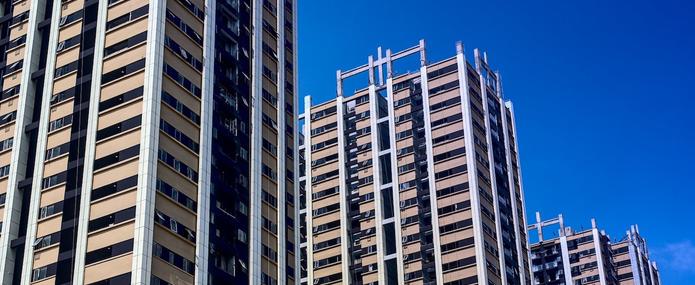Energy renovation of buildings in the French recovery plan
An opportunity to be seized and pitfalls to be avoided
This article was originally published as a blog post on the website of the French think-tank IDDRI. Energy Cities re-publishes it with the courtesy of its author Andreas Rüdinger, associate research fellow at IDDRI.

Energy renovations are a priority for post-crisis recovery plans, both in France, in the European Union and in the world.1 This urgency can be explained both by its rapidly mobilizable economic potential, its key role for climate policies, and by the importance of the fight against energy poverty in a context of increasing vulnerabilities. While proposals for France’s recovery plans abound,2 the challenge now is to identify the most effective levers for combining economic recovery with scaling-up of highly performant deep retrofits, which is a prerequisite for moving onto a convergent path with France’s national low-carbon strategy.
A key sector with a rising lag behind targets
Buildings alone account for 45% of the energy consumed in France (two thirds of which is residential and one third tertiary).3 This energy consumption accounts for 28% of greenhouse gas emissions in France;4 emissions that have hardly decreased since 1990 (-3%), making it the “laggard” sector of the first carbon budget (2015-2018) with a 12% overrun compared to the sectoral objective. This is mainly due to the slow progress in the energy retrofitting sector. Faced with the objective of bringing the entire housing stock up to the “low-energy building” (BBC) performance level by 2050 and of renovating 500,000 housing units per year, progress remains timid, insofar as it can be measured in the absence of reliable data on the number and quality of renovations.5
A significant potential in economic and employment terms
The Ademe’s “Marchés et Emplois” (Markets & Jobs) study indicates that the energy retrofitting sector represented more than 200,000 jobs and generated 29 billion euros of revenues in 2016. According to the hypotheses of the “Rénovons” (Let’s retrofit) scenario, an ambitious plan to eradicate the most energy-inefficient homes (energy class F and G housing) could create up to 93,000 additional jobs over ten years; an estimate that is in line with the evaluation carried out by I4CE in a recent analysis and which identifies ways to double investments in 5 years for high-performance retrofitting.
Such an approach entails two major risks. On the one hand, the increase in the volume of activity would fade quickly after the disappearance of the exceptional measures, creating a bubble of activity with no lasting impact over time. On the other hand, relying exclusively on existing tools entails the risk of retaining or even amplifying their weaknesses. In this case, the risk is that it will only encourage single and disparate energy retrofitting measures, which are disconnected and often incompatible with the logic of a comprehensive and deep energy retrofits. Furthermore, this would increase the risks of windfall effects in the event of targeted subsidies for specific equipment, thereby greatly reducing the overall economic efficiency.6
Triggering the global retrofitting market in France via the recovery plan
In contrast, a strategy consistent with the objectives set must aim to combine measures that can generate an increase in activity in the very short term with actions aimed at seizing this opportunity to resolutely initiate the change of scale in the market for deep and highly efficient renovations, which is still lacking. Such a strategy could be based on several orientations.
In the short term, integrating a new component in the existing support schemes, which would be directly focused on high-performance “BBC” renovations, in order to eliminate an important paradox in French renovation policy: faced with the objective of bringing the entire housing stock up to a “BBC” level by 2050, not a single national support tool is currently conditional on reaching this level of performance, thereby slowing down the emergence of the deep retrofitting market. The amount of this subsidy should be up to the challenge, in order to provide a clear and credible signal to all stakeholders (owners, building tradesmen) on the expansion of the deep retrofitting market.7
On the basis of the recommendations resulting from the Citizens’ Climate Convention, aiming, in the medium term, at an overhaul of all the existing mechanisms, in order to create a coherent strategy around three complementary lines:
- a single and simple aid scheme for households, modulated according to their resources and the energy performance level achieved after completion of the retrofit, and distributed by local one-stop-shops that provide support to owners during all phases of the project (initial audit, financial engineering and technical set-up of the project, evaluation of the quality of the retrofit), while coordinating all public and private stakeholders in the market.8
- establishing a credible long-term strategy on the implementation and progressive reinforcement of energy retrofitting obligations in line with the objective of a “BBC” energy-efficient building stock in 2050: in order to avoid “threshold effects” (moving from class F or G to class E, without going any further) and to encourage owners to commit to deep retrofits whenever possible.
- support for structuring a competitive, high-quality global retrofitting supply market, capable of keeping pace with the accelerating market: by stepping up on-site training initiatives and structuring groups of local craftsmen able to provide a comprehensive deep retrofitting service, by improving the reliability and enforceability of energy performance diagnostics, and by making “BBC” retrofitting a central component of initial training in the building sector.
The challenge for the recovery plan is therefore twofold: providing a strong signal to create an upsurge in the energy-efficient retrofitting market in the short term (some people use the term “Marshall Plan for buildings »); but this effort must be directed to prepare the ground for the implementation of the strategic orientations issued by the Citizens’ Climate Convention. Implementation which could be detailed in the framework of the elaboration of the five-year roadmap for the energy retrofitting of buildings included in article 1 of the 2019 energy-climate law.
- 1. https://www.iea.org/news/iea-offers-world-governments-a-sustainable-recovery-plan-to-boost-economic-growth-create-millions-of-jobs-and-put-emissions-into-structural-decline
- 2. For further information, following is a (non-exhaustive) list of proposals for the recovery plan focused on the subject of energy renovation: Senate Sénat (http://www.senat.fr/fileadmin/Fichiers/Images/commission/affaires_eco/Covid-19/Feuille_de_route_relance_energie_04-06-2020.pdf); Négawatt (https://www.negawatt.org/IMG/pdf/200611_note_plan-de-relance_reno-performante.pdf); I4CE (https://www.i4ce.org/wp-core/wp-content/uploads/2020/04/I4CE-Investir-pour-le-climat-sortie-de-crise-COVID-1.pdf); CSCEE (https://www.actu-environnement.com/media/pdf/news-35644-cscee-relance-propositions-secteur.pdf); Convention citoyenne pour le Climat (https://propositions.conventioncitoyennepourleclimat.fr/) ; Association des régions de France (http://regions-france.org/wp-content/uploads/2020/04/20200406-DP-relance.pdf). Also of interest is the draft bill on the “Climate Premium” (Prime climat): (https://lessocialistes.fr/wp-content/uploads/2020/05/Groupe-Socialistes-et-apparente%CC%81s-Proposition-de-loi-Prime-pour-le-Climat-2020-1.pdf), by the deputy Boris Vallaud, which is particularly comprehensive on the link between a progressive energy retrofitting obligation and an overhaul of aid for renovation work.
- 3. Energy consumption in the residential-tertiary sector is stable overall (+4% since 2000). Emissions from buildings fell by only 3% between 1990 and 2007, as gains in efficiency and energy decarbonisation were generally “offset” by the increase in surface areas.
- 4. According to the new national low-carbon strategy adopted in 2020, the residential-tertiary sector accounts for 19% of national emissions in Scope 1 and 28% in Scope 2, including emissions linked to the production of energy consumed in buildings (in particular electricity and heating networks).
- 5. In its first annual report for 2019, the High Council for the Climate (HCC) noted as follows: “The absence of a performance requirement and monitoring system for most thermal retrofitting operations (even when they receive financial support) means that there is no quality of results or reliable data to properly assess the progress made in relation to the objectives set by the SNBC and the effectiveness of renovation aid”.
- 6. The risk of windfall profits is particularly high when subsidies are targeting specific equipments (wood stoves, heat pumps, windows) or retrofitting measures (attic insulation, roofing, etc.), rather than establishing an overall subsidy based on the level of performance achieved after completion of the work. For a more detailed analysis, see for example the evaluation of retrofitting subsidies published by the CGEDD and IGF in 2017 (https://cgedd.documentation.developpement-durable.gouv.fr/documents/Affaires-0009660/010867-01_rapport.pdf) or this article by Bozonnat et al. (2016) (https://hal-enpc.archives-ouvertes.fr/hal-01336704/document).
- 7. In terms of the amount of support for overall retrofitting, the comparison with the German KfW scheme (recently reinforced) can serve as a reference: in France, the CITE finances a maximum of 4,800 euros for a couple, the ANAH Renov bonus can reach up to 20,000 euros for very modest households, depending above all on the planned retrofitting measures. In Germany, high-performance retroffiting is subsidised up to 48,000 euros per housing unit (maximum 40 % of the overall investment); this subsidy depends exclusively on the achievement of the targeted performance level, regardless of the planned measures and household income. The concept of a one-stop-shop does not imply a priori that only one actor is in charge of the whole support of the owners, but rather to constitute a unique interface which facilitates the coordination between the owner and all the actors intervening in the different phases of the retrofitting project (territorial platforms and energy info spaces, architects, thermal experts, craftsmen, etc.). For more details, see this Ademe report on support for households in renovating their homes (2019) (https://gbrisepierre.fr/wp-content/uploads/2019/12/ADEME-2019-Accompagner-la-r%C3%A9novation-Rapport-synthetique.pdf).
- 8. The concept of a one-stop-shop does not imply a priori that only one actor is in charge of the whole support of the owners, but rather to constitute a unique interface which facilitates the coordination between the owner and all the actors intervening in the different phases of the retrofitting project (territorial platforms and energy info spaces, architects, thermal experts, craftsmen, etc.). For more details, see this Ademe report on support for households in renovating their homes (2019) (https://gbrisepierre.fr/wp-content/uploads/2019/12/ADEME-2019-Accompagner-la-r%C3%A9novation-Rapport-synthetique.pdf).

